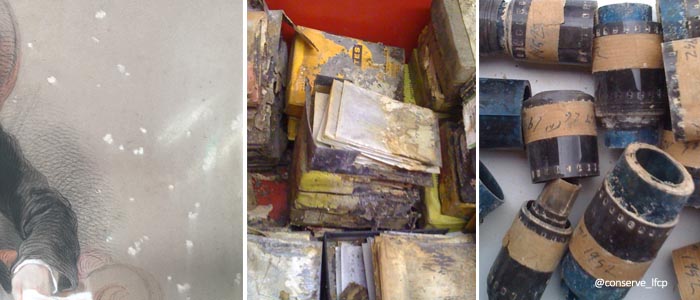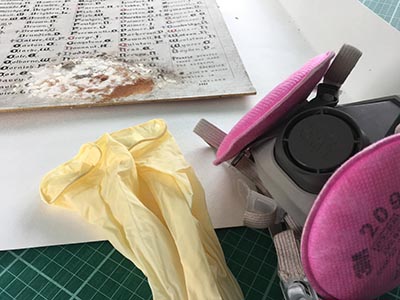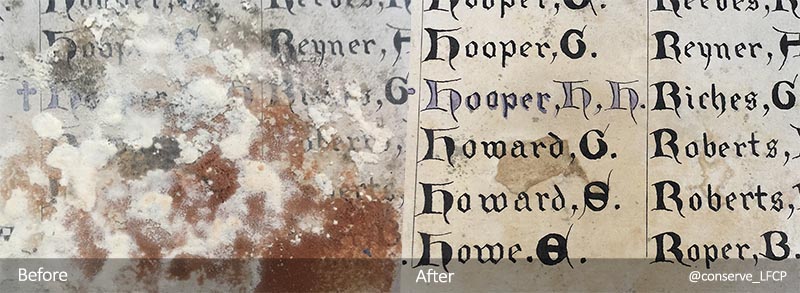A guest post from Lorraine Finch ACR, conservator of paper and photographs
In this season of mists and mellow fruitfulness, it's very timely to be writing about mould. This is the season for gathering mushrooms. And why are they growing? Because fungi love the damp. This is the time to check your precious family heirlooms and treasured collections for mould.
You can view our video webinar on mould here
What causes mould?
Mould spores are all around us all the time. Mould spores can lay dormant for long periods, just waiting for the conditions to be right before they can grow. So, what do they need?

- Something to grow on and to provide food for their growth. This is your family heirlooms, such as drawings, wedding dresses, christening gowns, leather, letters, tape cassettes or vinyl records, films, photographs and many other items which are precious to you.
- Mould needs the air to be damp; to have a high moisture content. Conservators call this Relative Humidity or RH for short. An RH of over 70% is generally agreed to be the point at which mould will grow on your heirlooms. However, mould can grow at a RH of 60% or lower, especially if the item has been affected with mould in the past. There are many different causes of a high RH in the home, this could be from the bathroom, cooking, poor ventilation which allows pockets of damp air to build up, a disaster like a burst pipe or flood and even your own breath.
I had several calls in 2018 from distraught home owners whose pipes had burst following the ‘Beast from the East’ which brought sub-freezing temperatures and inches of snow during spring in the UK. They had rescued the family, the pets, the electrical goods, mopped up the water, called the insurance company - but about a week later realised that their photographs and books were wet and mouldy.
Mould growth is can also be encouraged by dark conditions and lack of air movement, such as behind wardrobes and cabinets, or even inside them! You can easily monitor the RH of your storage area using a Thermohygrometer such as this one which will highlight peaks in humidity.
Mould is very damaging
Mould growth can lead to the complete destruction and loss of your treasured possessions and collections due to discolouration, staining and weakening, spoiling your treasured wedding dress, rare book or vinyl record forever more. It can cause photographs and papers to stick together. It can be very difficult, and sometimes impossible, to get such damaged objects apart.

Above: Mould present on a pastel, a photographic collection and negatives.
But it’s not only your possessions that are affected, mould can also be very damaging to you.
It can cause serious physical and psychological effects. Symptoms can include nasal irritation, stuffiness and congestion, throat irritation and soreness, a cough, chest congestion, severe headache, dizziness, problems with your concentration, irritability, fatigue, blurry vision, skin rash and low-grade fever and flu-like symptoms. Some moulds may cause serious and potentially life-threatening symptoms. Family members with asthma or respiratory problems, those with compromised immune systems and those taking steroids are more susceptible to the damaging effects of mould.

So how should you protect yourself when handling mould?
Because of the damaging effects of mould it is very important that you wear personal protection equipment [PPE] when you are handling your heirlooms that are infected with it. You should wear gloves (latex or nitrile) and a mask which conforms with European Standard EN 149 category FFP2S. You may want to reduce the amount of mould spores which collect on your clothes and hair by wearing a disposable Tyvek coverall. Dispose of your used PPE in a sealed bag to avoid contaminating other areas of your house and other people.
What to do with your mould damaged heirlooms once you have protected yourself.
If you have found mould on one or two heirlooms or if you have a major outbreak in your home, your mouldy items should be isolated into sealed bags or boxes until they can be dealt with. If you have the space, line a table with lining wallpaper or archival blotting paper and place your items on it so that the air can circulate around them, which will kill the mould. I have seen mould go from rampant growth to dead in a matter of hours, once it is placed in an area with good ventilation. Remove any framed items from their frame if you feel confident that you can do this without causing any damage to the artwork or photograph. You can place fans in the room to increase air movement. If your objects are very damp or even wet, as the result of a flood, it would be a good idea to place a dehumidifier in the room.
It goes without saying that this room should be off limits to family members who are vulnerable or who if they are not wearing PPE. Any visible mould in the areas where your heirlooms were kept, such as shelves, cupboards and chests can be removed using a vacuum cleaner fitted with High Efficiency Particulate Air [HEPA] filters.
To ensure that your collection isn’t damaged when mould is removed, it’s recommended that the work is done by an accredited conservator.

An accredited conservator in your local area and specialising with your type of collection can be found on the Conservation Register: www.conservationregister.com.
Watch the process of mould removal from a WW1 Roll of Honour below.
Now you have a mould free space in your house and clean treasured items, how do you prevent a further mould outbreak?
You will by now have identified the cause of the mould outbreak, whether it was the result of a leaking pipe, or the result of your storage area being damp with poor ventilation. You've had the leaking pipe fixed and you know that you have problems with damp areas with poor ventilation.
Good preventive measures include:
- low temperatures (below 10ºC) and a low relative humidity (below 70%)
- reduce the amount of moisture in the air by simple steps such as keeping bathroom and kitchen doors closed when they're in use. Opening a window when cooking. The easiest way to check the RH is to use a thermohygrometer to check what the temperature and RH are. (p.161 – 805-2000) If the RH is above 70%, or you are concerned consider using a dehumidifier.
It is a good idea to periodically check for signs of mould on your collection, artwork, heirlooms, or in the surrounding storage area. Although mould can grow on your heirlooms at any time of the year, spring and autumn are the key times for mould growth. Storage should be off floors and away from outside walls, especially cold, north-facing walls. You should ensure that there is a good circulation of air around your items. You can increase the circulation of air with fans or by opening windows and doors occasionally.
Keep your heirlooms clean. Dust with a dusting cloth as required. And finally, think ahead. Conservators call this disaster prevention. Keep your house watertight. Prevent damp from entering your house; don’t ignore those overflowing gutters, and cracked tiles. Move your heirlooms away from sources of water such as pipes, taps and radiators.
Now you have a mould free house, a clean storage or display area and you’ve protected your collection or heirloom for your future and for future generations. It's time to sit down with a nice cup of tea, maybe even a packet of biscuits, just remember to take your mask off first!
You can contact Lorraine Finch in the following ways:
E: paperconservation@btinternet.com
| W: www.lfcp.co.uk
| T: @conserve_lfcp |
Facebook: LFCandP